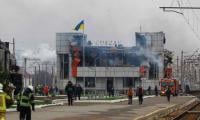ISLAMABAD: Inflation, as measured by the Consumer Price Index (CPI), reached a two-year high of 13.37 per cent in April 2022, compared to the same month a year ago, and was 1.6 per cent higher than the previous month, according to the Pakistan Bureau of Statistics (PBS) on Sunday. Food and energy costs were the primary contributors to the high level of inflation.
The inflation rate in April was the highest since June 2011 (in eleven years). In June 2011, the CPI was recorded at 13.3 per cent, and in January 2020, it was at 14.6 per cent. It should be noted that inflation has remained in double digits for the sixth month in a row and has reached a two-year high. This has pushed the ten-month average inflation rate (July-April 2021-22) to 11.04 per cent, exceeding the State Bank of Pakistan's anticipated upper limit for inflation. The central bank projected that CPI to be 9 to 11 per cent by the end of this fiscal year.
Similarly, the International Monetary Fund (IMF) warned Pakistan in its most recent World Economic Outlook that rising inflation and the external environment had increased near-term risks. The fund sharply revised its previous projections, predicting that Pakistan's current account deficit (CAD) would reach $18.5 billion and average inflation would be 12.7 per cent by this fiscal year.
Rising food prices, according to economists, were the primary driver, followed by vehicle fuels and electricity charges. They claimed that the recent acceleration in inflation was due to supply chain disruptions, high transportation charges, and surging global commodity prices. “Imported inflation (high energy and commodity prices) also plays a role in driving up economic prices,” an economist explained.
Inflation is viewed as an 'unseen tax' or penalty on cash holders, eroding purchasing power, and has become a politically sensitive topic. The ten-month inflation (July-April) was 11.04 per cent, compared to 8.62 per cent in the same period last year.
The Consumer Price Index (CPI) is a basket of goods that tracks retail prices of 374 items in 35 major cities. Its two major components with the highest weightage, food and beverages with a share of more than one-third (or 34.58 per cent), and utility charges (housing, water, electricity, and fuel) with around one-fourth (or 23.63pc share) become significantly more expensive during April. Clothing & footwear and transportation charges also increased sharply. It is to be noted that inflation has been an increasing trend for the last several months that has primarily affected the lower middle class. But the government is attributing the high inflation to increased commodity prices, including food and crude in the international market, while the supply-chain disruption also created shortages. Currently, Pakistan is a net importer of wheat, pulses, sugar, edible oil, and other food items.
According to the statistics office, CPI in April 2021 was at 11.1 per cent, and now it arrived at 13.37 per cent. In March 2022, the CPI was at 12.72 per cent.
According to PBS, urban inflation increased by 12.2 per cent yearly in April 2022 compared to 11.9 per cent in the previous month and 11 per cent in April 2021.
Similarly, rural CPI inflation increased by 15.1 per cent on a year-on-year basis in April 2022 compared to an increase of 13.9 per cent in the previous month and 11.3 per cent in April 2021. Over the last month, urban and rural inflation both increased 1.6 per cent. Urban core CPI (excluding the food and energy components) increased by 9.1 per cent year-on-year in April 2022 against 8.9 per cent in the previous month and 7 per cent a year ago. And it rose 1.1 per cent over the last month.
Likewise, rural core-CPI increased 10.9 per cent Y-on-Y in April 2022 compared to 10.3 per cent in the last month and 7.7 per cent in April 2021. On-month-on-month basis, it increased by 1.2 per cent in April over the previous month.
The Wholesale Price Index (WPI) showed a 28.1 per cent increase in April compared to 23.8 per cent a month earlier and only 16.6 per cent in April 2021. WPI inflation on a month-on-month basis increased by 3.2 per cent during April. The sharp increase in WPI indicates that the CPI inflation in the coming months can go further high, as the WPI always has a lag effect on the retail prices.
The Sensitive Price Indicator (SPI) also increased 14.2 per cent in April 2022 compared to 13 per cent last month and 21.3 per cent in the same month of the previous year. It also increased by 1.5 per cent in April over the last month.
According to the PBS, during the month, food and beverage prices increased by 17.04 per cent from 15.3 per cent in the previous month.
In the food group, in one month, the chicken price increased by 33.6 per cent, fruit by 15.2 per cent, mustard oil by 8.7 per cent, vegetable ghee by 8.3 per cent, onions by 7 per cent, cooking oil by 5 per cent, gram whole by 2.1 per cent, tea 1.9 per cent, milk 1.5 per cent and besan by 1 per cent over the previous month. However, tomatoes prices fell 36.5 per cent, eggs 14.7 per cent, wheat 4.9 per cent, potatoes 3.7 per cent, condiments & spices 2.4 per cent, gur 1.1 per cent, wheat flour, and sugar prices down by 1 per cent each.
Year on year, tomatoes price up 149 per cent, mustard oil 60 per cent, vegetable ghee 50 per cent, cooking oil 48 per cent, masoor pulse 38 per cent, vegetables 35 per cent, fruits 32 per cent, whole gram 25 per cent, meat 24 per cent, chicken 20 per cent, and besan 14 per cent.
However, moong pulse prices are down 27 per cent, eggs 20 per cent, condiments & Spices 15 per cent, Sugar 10.7 per cent, and potatoes 9.5 per cent.
Utility charges (housing, water, electricity, and fuel) increased by 7.05 per cent in April 2022. On a month-on-month basis, liquified hydrocarbon price was up 7.8 per cent, woolen cloth 3.14 per cent, furniture & furnishing 2.5 per cent, construction input items 2 per cent, stationery 1.8 per cent, motor vehicles 1.76 per cent, cotton cloth 1.42 per cent, motor vehicle accessories 1.4 per cent and washing soap/detergents/matchbox became dearer by 1 per cent over the previous month.
Year-on-year, liquefied hydrocarbons price up 79 per cent, motor fuel 37 per cent, cleaning & laundering 24 per cent, washing soap/detergents/matchbox 17 per cent, motor vehicle accessories 16 per cent, solid fuel price up 13 per cent over the same month of last year.
The other components of the CPI also showed an increase in their prices. The transport sector, although having a low share in the CPI basket, its charges increased the highest with 28.34 per cent, furnishing, and household equipment maintenance at 14.66 per cent, hoteling at 14.57 per cent, clothing and footwear at 10.84 per cent, health charges at 10.37 per cent, recreation and culture 9.65 per cent. Similarly, education charges up 8.36 per cent and communication charges 1.61 per cent over the corresponding month of last year.















